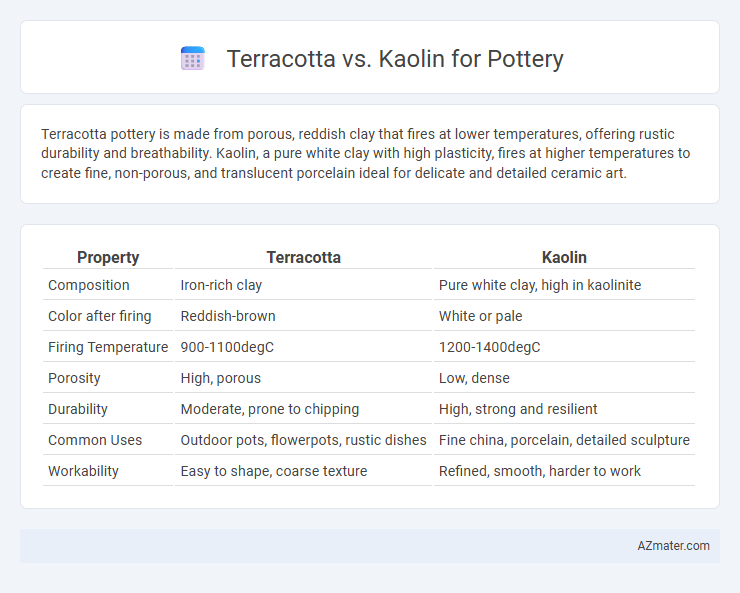Terracotta pottery is made from porous, reddish clay that fires at lower temperatures, offering rustic durability and breathability. Kaolin, a pure white clay with high plasticity, fires at higher temperatures to create fine, non-porous, and translucent porcelain ideal for delicate and detailed ceramic art.
Table of Comparison
| Property | Terracotta | Kaolin |
|---|---|---|
| Composition | Iron-rich clay | Pure white clay, high in kaolinite |
| Color after firing | Reddish-brown | White or pale |
| Firing Temperature | 900-1100degC | 1200-1400degC |
| Porosity | High, porous | Low, dense |
| Durability | Moderate, prone to chipping | High, strong and resilient |
| Common Uses | Outdoor pots, flowerpots, rustic dishes | Fine china, porcelain, detailed sculpture |
| Workability | Easy to shape, coarse texture | Refined, smooth, harder to work |
Introduction to Terracotta and Kaolin
Terracotta is a porous, iron-rich clay known for its reddish-brown color and durability, commonly used in traditional pottery and architectural elements. Kaolin, a white, fine-grained clay composed primarily of kaolinite, offers a smooth texture ideal for porcelain and fine ceramics due to its high plasticity and low impurity content. Both clays provide distinct properties suited for different pottery techniques and aesthetic outcomes.
Origins and Composition of Terracotta
Terracotta, a type of earthenware clay originating from regions such as Italy and India, consists primarily of iron-rich clay that imparts its characteristic reddish-brown hue after firing. Unlike kaolin, which is a white, pure clay composed mainly of the mineral kaolinite and sourced mainly from China and the southeastern United States, terracotta contains higher levels of iron oxide and other mineral impurities. This composition affects terracotta's porosity and durability, making it ideal for traditional pottery, sculpture, and architectural elements.
Chemical Properties of Kaolin
Kaolin, a primary clay composed mainly of the mineral kaolinite (Al2Si2O5(OH)4), exhibits high purity with low iron content, resulting in its characteristic white color and reduced firing shrinkage compared to terracotta. The chemical stability and minimal plasticity of kaolin make it ideal for fine, detailed pottery that requires high-temperature firing without warping. Its refractory properties allow kaolin-based ceramics to withstand temperatures above 1400degC, contrasting with terracotta's lower firing range and higher porosity due to iron oxide presence.
Color and Texture Differences
Terracotta exhibits a warm, reddish-orange color due to its iron-rich clay, offering a porous texture that is slightly coarse and rustic, ideal for traditional pottery and outdoor use. Kaolin, also known as white clay, is prized for its pure white color and smooth, fine texture, which provides a pristine finish suited for delicate and high-fired ceramics like porcelain. The distinct color and texture differences influence the firing temperature and glaze compatibility, making terracotta more absorbent and kaolin more vitrified and durable after firing.
Workability and Forming Techniques
Terracotta clay offers excellent workability for hand-building techniques due to its coarser texture and higher plasticity, making it ideal for sculptural forms and wheel throwing. Kaolin, known for its fine, pure composition, provides a smooth surface but requires more precise handling and is better suited for delicate, detailed work such as slip casting and porcelain pottery. Both clays demand different forming techniques: terracotta excels in thicker, more rustic pieces, while kaolin favors refined, thin-walled vessels with a delicate finish.
Firing Temperatures and Methods
Terracotta typically fires at lower temperatures between 1000degC and 1150degC, resulting in a porous and reddish finish ideal for rustic pottery. Kaolin (or porcelain clay) requires higher firing temperatures ranging from 1200degC to 1400degC, producing a dense, white, and vitrified surface suitable for fine ceramics. The firing method for terracotta often involves oxidation in traditional kilns, while kaolin benefits from controlled atmospheres in high-temperature electric or gas kilns to achieve its characteristic strength and translucency.
Durability and Porosity Comparison
Terracotta exhibits higher porosity compared to kaolin, resulting in increased water absorption and reduced durability, which makes it more prone to chipping and cracking under stress. Kaolin, a primary ingredient in porcelain, offers low porosity and superior strength due to its refined particle size and high firing temperature, enhancing the pottery's resistance to wear and moisture. The durability advantage of kaolin over terracotta is significant for applications requiring longevity and structural integrity in ceramic goods.
Glazing Compatibility
Terracotta's porous, iron-rich clay body absorbs glaze differently than kaolin, resulting in varying glaze adherence and finish. Kaolin, valued for its purity and whiteness, offers superior compatibility with a wide range of glazes, producing smooth and bright finishes due to its low iron content. The high firing temperature tolerance of kaolin enhances glaze durability compared to the more absorbent and lower-fired terracotta.
Best Uses for Terracotta and Kaolin Pottery
Terracotta pottery, characterized by its porous reddish-brown clay, is best suited for outdoor planters, garden pots, and rustic decorative items due to its excellent breathability and natural insulation properties. Kaolin, a white-firing, fine-grained clay, is ideal for delicate porcelain, fine china, and intricate ceramic art because of its smooth texture, high plasticity, and ability to withstand high firing temperatures without deforming. Both clays serve distinct purposes: terracotta excels in durability and permeability for functional, earthy vessels, while kaolin offers precision and elegance for refined, translucent ceramics.
Choosing the Right Clay for Your Pottery Project
Terracotta and kaolin are both popular clays but serve different pottery needs; terracotta is rich in iron oxide, giving it a distinctive reddish color and porous quality ideal for outdoor pots and rustic decorations. Kaolin, also known as china clay, is white, fine-grained, and highly plastic, making it perfect for delicate, detailed work like fine porcelain and high-fired ceramics. Selecting the right clay depends on your project's firing temperature, desired finish, and functionality, with terracotta suited for low-fire, absorbent pieces, and kaolin best for high-fire, vitrified, and smooth-textured pottery.

Infographic: Terracotta vs Kaolin for Pottery
 azmater.com
azmater.com